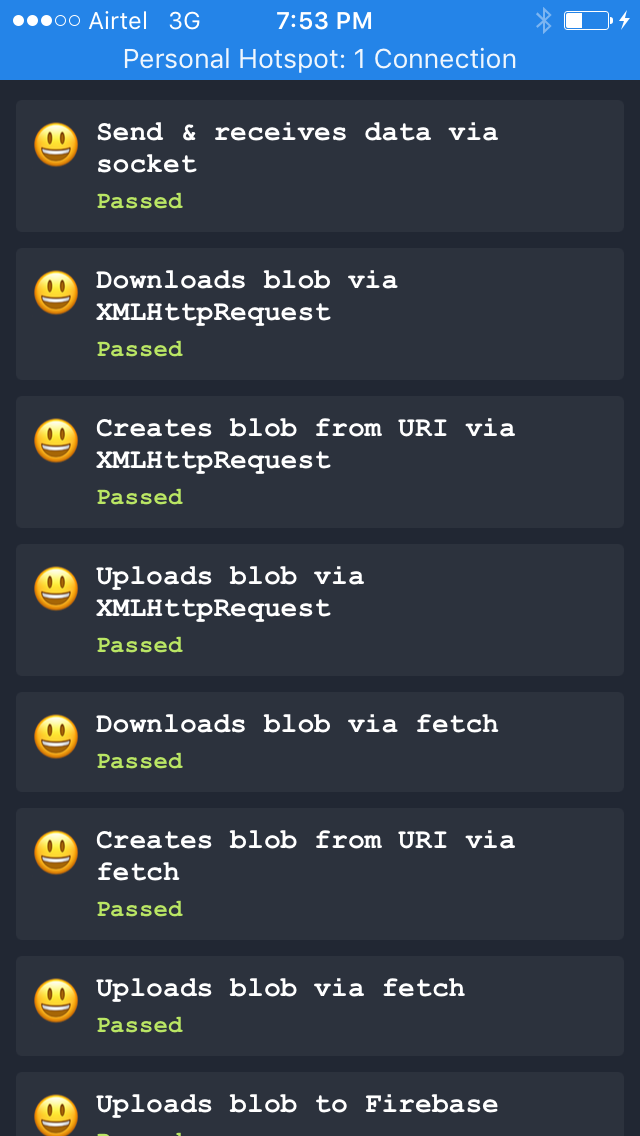Summary: This change drops the year from the copyright headers and the LICENSE file.
Reviewed By: yungsters
Differential Revision: D9727774
fbshipit-source-id: df4fc1e4390733fe774b1a160dd41b4a3d83302a
Summary:
Includes React Native and its dependencies Fresco, Metro, and Yoga. Excludes samples/examples/docs.
find: ^(?:( *)|( *(?:[\*~#]|::))( )? *)?Copyright (?:\(c\) )?(\d{4})\b.+Facebook[\s\S]+?BSD[\s\S]+?(?:this source tree|the same directory)\.$
replace: $1$2$3Copyright (c) $4-present, Facebook, Inc.\n$2\n$1$2$3This source code is licensed under the MIT license found in the\n$1$2$3LICENSE file in the root directory of this source tree.
Reviewed By: TheSavior, yungsters
Differential Revision: D7007050
fbshipit-source-id: 37dd6bf0ffec0923bfc99c260bb330683f35553e
Summary:
This PR is a followup to https://github.com/facebook/react-native/pull/11417 and should be merged after that one is merged.
1. Add support for creating blobs from strings, not just other blobs
1. Add the `File` constructor which is a superset of `Blob`
1. Add the `FileReader` API which can be used to read blobs as strings or data url (base64)
1. Add support for uploading and downloading blobs via `XMLHttpRequest` and `fetch`
1. Add ability to download local files on Android so you can do `fetch(uri).then(res => res.blob())` to get a blob for a local file (iOS already supported this)
1. Clone the repo https://github.com/expo/react-native-blob-test
1. Change the `package.json` and update `react-native` dependency to point to this branch, then run `npm install`
1. Run the `server.js` file with `node server.js`
1. Open the `index.common.js` file and replace `localhost` with your computer's IP address
1. Start the packager with `yarn start` and run the app on your device
If everything went well, all tests should pass, and you should see a screen like this:
!
Pull to rerun all tests or tap on specific test to re-run it
[GENERAL] [FEATURE] [Blob] - Implement blob support for XMLHttpRequest
Closes https://github.com/facebook/react-native/pull/11573
Reviewed By: shergin
Differential Revision: D6082054
Pulled By: hramos
fbshipit-source-id: cc9c174fdefdfaf6e5d9fd7b300120a01a50e8c1
Summary:
This is the first PR from a series of PRs grabbou and me will make to add blob support to React Native. The next PR will include blob support for XMLHttpRequest.
I'd like to get this merged with minimal changes to preserve the attribution. My next PR can contain bigger changes.
Blobs are used to transfer binary data between server and client. Currently React Native lacks a way to deal with binary data. The only thing that comes close is uploading files through a URI.
Current workarounds to transfer binary data includes encoding and decoding them to base64 and and transferring them as string, which is not ideal, since it increases the payload size and the whole payload needs to be sent via the bridge every time changes are made.
The PR adds a way to deal with blobs via a new native module. The blob is constructed on the native side and the data never needs to pass through the bridge. Currently the only way to create a blob is to receive a blob from the server via websocket.
The PR is largely a direct port of https://github.com/silklabs/silk/tree/master/react-native-blobs by philikon into RN (with changes to integrate with RN), and attributed as such.
> **Note:** This is a breaking change for all people running iOS without CocoaPods. You will have to manually add `RCTBlob.xcodeproj` to your `Libraries` and then, add it to Build Phases. Just follow the process of manual linking. We'll also need to document this process in the release notes.
Related discussion - https://github.com/facebook/react-native/issues/11103
- `Image` can't show image when `URL.createObjectURL` is used with large images on Android
The websocket integration can be tested via a simple server,
```js
const fs = require('fs');
const http = require('http');
const WebSocketServer = require('ws').Server;
const wss = new WebSocketServer({
server: http.createServer().listen(7232),
});
wss.on('connection', (ws) => {
ws.on('message', (d) => {
console.log(d);
});
ws.send(fs.readFileSync('./some-file'));
});
```
Then on the client,
```js
var ws = new WebSocket('ws://localhost:7232');
ws.binaryType = 'blob';
ws.onerror = (error) => {
console.error(error);
};
ws.onmessage = (e) => {
console.log(e.data);
ws.send(e.data);
};
```
cc brentvatne ide
Closes https://github.com/facebook/react-native/pull/11417
Reviewed By: sahrens
Differential Revision: D5188484
Pulled By: javache
fbshipit-source-id: 6afcbc4d19aa7a27b0dc9d52701ba400e7d7e98f
Summary:
To make React Native play nicely with our internal build infrastructure we need to properly namespace all of our header includes.
Where previously you could do `#import "RCTBridge.h"`, you must now write this as `#import <React/RCTBridge.h>`. If your xcode project still has a custom header include path, both variants will likely continue to work, but for new projects, we're defaulting the header include path to `$(BUILT_PRODUCTS_DIR)/usr/local/include`, where the React and CSSLayout targets will copy a subset of headers too. To make Xcode copy headers phase work properly, you may need to add React as an explicit dependency to your app's scheme and disable "parallelize build".
Reviewed By: mmmulani
Differential Revision: D4213120
fbshipit-source-id: 84a32a4b250c27699e6795f43584f13d594a9a82
Summary:
This allows consumers to subclass and extend `RCTWebSocketModule` and make use of the `RCTSRWebSocketDelegate` methods.
The use case here is to do some pre-processing of WebSocket data before handing it off to JS. Consumers could that in the following way:
```
interface MyWebSocketModule : RCTWebSocketModule
end
implementation MyWebSocketModule
// Don't use RCT_EXPORT_MODULE macro for this so we replace the existing RCTWebSocketModule.
+ (NSString *)moduleName { return @"RCTWebSocketModule"; }
RCT_EXTERN_METHOD(connect:(NSURL *)URL socketID:(nonnull NSNumber *)socketID)
RCT_EXTERN_METHOD(send:(NSString *)message socketID:(nonnull NSNumber *)socketID)
RCT_EXTERN_METHOD(close:(nonnull NSNumber *)socketID)
- (void)webSocket:(RCTSRWebSocket *)webSocket didReceiveMessage:(id)message
{
[super webSocket:webSocket didReceiveMessage:[DoSomethingWith message]];
}
end
```
... and then returning a `MyWebSocketModule` ins
Closes https://github.com/facebook/react-native/pull/5321
Reviewed By: svcscm
Differential Revision: D2832374
Pulled By: nicklockwood
fb-gh-sync-id: f208516b2b2f76276223ffc972871d96afe87e27
Summary: The JavaScript code for Android is same as the iOS counterpart, I just added few new lines and used arrow functions instead of binding `this`.
Closes https://github.com/facebook/react-native/pull/2839
Reviewed By: @svcscm, @vjeux
Differential Revision: D2498703
Pulled By: @mkonicek
fb-gh-sync-id: 3fe958dd5af0efba00df07515f8e33b5d87eb05b